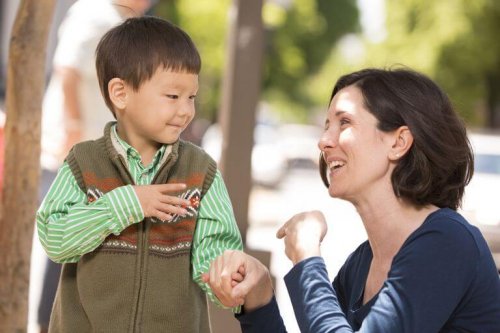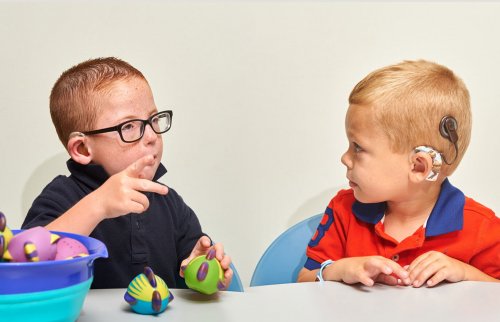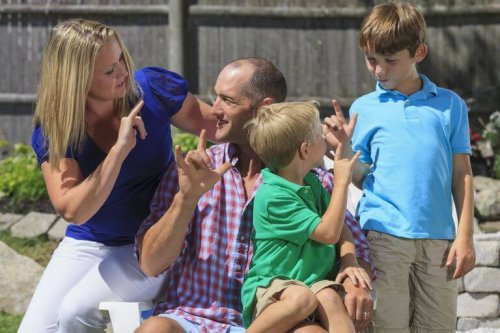Tips for Moms Raising a Deaf Child


Written and verified by the psychologist Ana Couñago
Having a child with an auditive disability can sometimes make you feel like society doesn’t understand you, which makes it even harder to bear. In this article, we’ll talk about raising a deaf child.
The fact that your child has hearing problems can also mean he or she might have difficulties at linguistic, cognitive, and social levels. You can work on these things both at home and at school.

Raising a deaf child
Raising a deaf child means adapting to a new situation and overcoming certain social barriers. The first challenge is accepting the diagnosis. A few hour hours after birth, most babies go through otoacoustic emissions to test their hearing skills, but deafness can still happen in later years.
It’s important to know and be aware of certain signals that might help you detect deafness early on. Pay attention in the following cases:
- Children between the ages of 1 and 2 who don’t understand simple commands, don’t recognize their name, don’t identify their body parts, only speak in monosyllables, or don’t pay attention to stories, etc.
- Children between the ages of 2 and 3 whose speech is unintelligible; they don’t repeat phrases nor answer simple questions.
- Children between the ages of 3 and 4 who don’t know how to talk about what’s going on or aren’t able to have a simple conversation.
- Children between the ages of 4 and 5 who don’t talk with other children or don’t have a mature language and only their family understands them.
Here are other situations to also keep an eye on:
- If there’s a lack of language, or it disappears, or maybe it evolves too slowly for their age.
- A total disconnection in class or if they have symptoms of learning difficulties at school.
- If they tend to have bad colds, ear pain, or allergies.

Guiding cues for raising a deaf child
Using technical assistance
After diagnosing the child’s deafness, the next step is deciding what technical assistance is best for his or her particular case.
The most commonly used assistance for deafness is the hearing aid. This device is like a miniature amplifier that can be used for specific hearing losses.
Another type of assistance is a hearing implant. Said implant is used when the child has a severe or deep hearing disability.
Adapting communicative practices
There are alternative systems that the child can learn to help him or her express and comprehend the speaking language. This can help a deaf child to establish social relations as normally as possible.
The child’s family needs to choose among the following:
- Learning sign language.
- Using a combination of language systems.
- Using cued speech.
- Learning to read lips.
- Using a phonetic alphabet.
Being in constant contact with the child’s school
If you’re raising a deaf child or a child who has some type of hearing disability, you need to create a trusting bond with his school and establish a constant flow of communication.
This way you’ll always be aware of what the school does to solve your child’s specific needs. You also need to show a positive and active attitude and follow the teacher’s advice.
Become part of a specialized organization
Specialized organizations are ideal to get in touch with other families in the same situation. In fact, organizations can help you:
- Deal with the situation without stressing out.
- Go through with grief.
- Creating a strong and emotional bond with the child.
- Think about what the future might hold for your child.
- Clearing out any worries or doubts about your child’s issue.

Getting the right information for raising a deaf child
Society, in general, is a little behind or misinformed about what it really means to be deaf or to have a hearing disability. Nowadays, there are still many stereotypes regarding deaf people, like talking to them very loud or too slow, by almost spelling everything out, which can really annoy the little ones.
In short, and to conclude this article, children with hearing disabilities, their families, and their community as a whole should take measures to really help them feel welcomed and able.
“Deafness should be seen as just another way of life, not as a limitation.”
Having a child with an auditive disability can sometimes make you feel like society doesn’t understand you, which makes it even harder to bear. In this article, we’ll talk about raising a deaf child.
The fact that your child has hearing problems can also mean he or she might have difficulties at linguistic, cognitive, and social levels. You can work on these things both at home and at school.

Raising a deaf child
Raising a deaf child means adapting to a new situation and overcoming certain social barriers. The first challenge is accepting the diagnosis. A few hour hours after birth, most babies go through otoacoustic emissions to test their hearing skills, but deafness can still happen in later years.
It’s important to know and be aware of certain signals that might help you detect deafness early on. Pay attention in the following cases:
- Children between the ages of 1 and 2 who don’t understand simple commands, don’t recognize their name, don’t identify their body parts, only speak in monosyllables, or don’t pay attention to stories, etc.
- Children between the ages of 2 and 3 whose speech is unintelligible; they don’t repeat phrases nor answer simple questions.
- Children between the ages of 3 and 4 who don’t know how to talk about what’s going on or aren’t able to have a simple conversation.
- Children between the ages of 4 and 5 who don’t talk with other children or don’t have a mature language and only their family understands them.
Here are other situations to also keep an eye on:
- If there’s a lack of language, or it disappears, or maybe it evolves too slowly for their age.
- A total disconnection in class or if they have symptoms of learning difficulties at school.
- If they tend to have bad colds, ear pain, or allergies.

Guiding cues for raising a deaf child
Using technical assistance
After diagnosing the child’s deafness, the next step is deciding what technical assistance is best for his or her particular case.
The most commonly used assistance for deafness is the hearing aid. This device is like a miniature amplifier that can be used for specific hearing losses.
Another type of assistance is a hearing implant. Said implant is used when the child has a severe or deep hearing disability.
Adapting communicative practices
There are alternative systems that the child can learn to help him or her express and comprehend the speaking language. This can help a deaf child to establish social relations as normally as possible.
The child’s family needs to choose among the following:
- Learning sign language.
- Using a combination of language systems.
- Using cued speech.
- Learning to read lips.
- Using a phonetic alphabet.
Being in constant contact with the child’s school
If you’re raising a deaf child or a child who has some type of hearing disability, you need to create a trusting bond with his school and establish a constant flow of communication.
This way you’ll always be aware of what the school does to solve your child’s specific needs. You also need to show a positive and active attitude and follow the teacher’s advice.
Become part of a specialized organization
Specialized organizations are ideal to get in touch with other families in the same situation. In fact, organizations can help you:
- Deal with the situation without stressing out.
- Go through with grief.
- Creating a strong and emotional bond with the child.
- Think about what the future might hold for your child.
- Clearing out any worries or doubts about your child’s issue.

Getting the right information for raising a deaf child
Society, in general, is a little behind or misinformed about what it really means to be deaf or to have a hearing disability. Nowadays, there are still many stereotypes regarding deaf people, like talking to them very loud or too slow, by almost spelling everything out, which can really annoy the little ones.
In short, and to conclude this article, children with hearing disabilities, their families, and their community as a whole should take measures to really help them feel welcomed and able.
“Deafness should be seen as just another way of life, not as a limitation.”
All cited sources were thoroughly reviewed by our team to ensure their quality, reliability, currency, and validity. The bibliography of this article was considered reliable and of academic or scientific accuracy.
- Delgado-Domínguez, J. J. (2011). Detección precoz de la hipoacusia infantil. Pediatría Atención Primaria, 13(50), 279-297.
- Marchesi, Á. (2012). Desarrollo y educación de los niños sordos. En Á. Marchesi, J. P. González y C. Coll (Ed.), Desarrollo Psicológico Y Educación: 3. Trastornos Del Desarrollo Y Necesidades Educativas Especiales (pp.241-269). Madrid: Alianza Editorial.
- Manchón, A. M. (2002). Las Tecnologías de Ayuda en la respuesta educativa del niño con discapacidad auditiva. Las nuevas tecnologías en la respuesta educativa a la diversidad, (63).
- Martín, E. M. (2010). Los sistemas alternativos y aumentativos. Pedagogía Magna, (5), 80-88.
This text is provided for informational purposes only and does not replace consultation with a professional. If in doubt, consult your specialist.








